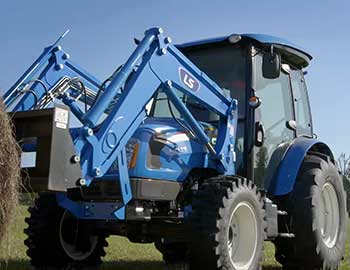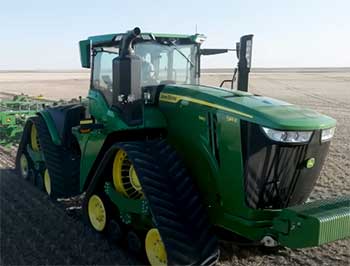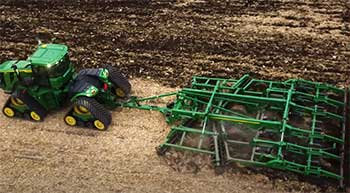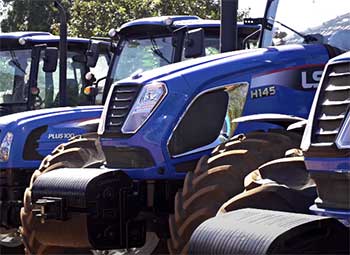When investing in a workhorse tractor for your fields or job sites, few decisions are more important than selecting the right brand. With so many models to choose from, it can be challenging to decipher which manufacturer offers the optimal blend of power, reliability and value for your specific needs.
Two of the most prominent brands on the agricultural and construction equipment landscape are industry giant John Deere and Korean budget upstart LS Tractors.
But when it comes to critical factors like engine performance, comfort, warranty and overall ownership value, significant differences emerge that equipment buyers should understand before purchasing.
Whether you operate a sprawling row crop farm or manage a landscaping crew on commercial sites, one of these brands likely matches your operational requirements and budgetary constraints.
By evaluating the relative strengths and weaknesses of Deere versus LS models across numerous data points, you can make an informed assessment to determine the ideal tractor pick based on total value.
A Brief Comparison Table
| Tractor Attribute | John Deere | LS Tractors |
| Brand History | 184 years as an industry leader known for quality and innovation | Budget “no-frills” tractors since 1970 focused on affordability |
| Engine & Powertrain | Proprietary PowerTech engines designed and built by Deere for performance, efficiency and reliability | Uses engines from Mitsubishi, Perkins, Deutz designed for cost savings rather than max power |
| Hydraulics Capacity | Up to 30 GPM flow and 5000 PSI pressure enables running multiple implements with precision | Peak around 15-16 GPM flow and 2500 PSI suited for basic single implement applications |
| Cab Comfort | Heated/cooled suspension seats, tilt telescopic wheel, Bluetooth, fridge and abundant storage for marathon comfort | Hard vinyl seats, limited adjustments and sparse amenities favor function over comfort |
| Technology Integration | Cutting-edge precision agriculture tools like GPS guidance, telematics data transfer and full ISOBus automation | Lacks advanced capabilities but costs less upfront and over time vs complex Deere systems |
| Warranties | 2 year / 2000 hour comprehensive coverage plus extensive dealer network for support | 1 year bumper-to-bumper protection supplemented by partner brand dealerships |
| Resale Value | Strong demand for used Deere models and high trade-in value thanks to brand reputation | Holds honest value but lacks the premium resale and trade-in status of Deere |
Brand History & Design Philosophies
First, let’s examine some background on both equipment manufacturers, which reveals divergent approaches to the tractor market based on opposing design schools of thought. This establishes some context on reliability expectations and customer focus from the outset.
- John Deere

As one of the oldest and most trusted names in agricultural equipment, John Deere stands as a legendary American brand founded in 1837.
Through nearly two centuries of providing industry leading tractors and implements, generations of farmers have relied upon green & yellow Deere models as stalwarts in their fields.
With this deeply ingrained legacy comes an expectation of quality, reliability and continued innovation from the brand’s tractors.
Their design approach centers on durability, advanced technology and integrated precision farming capabilities that maximize productivity per acre while minimizing total cost of operation.
As a premium equipment manufacturer serving commercial crop producers, Deere prioritizes features and performance specifications to enable immense output with limited downtime.
Their flagship tractor families with naming conventions like “R”, “M”, “S” and “T” have become icons in agriculture, known for power, comfort and technology integration from the factory.
If there is any shortcoming to these credentials, it comes primarily in the lofty window sticker prices attached to John Deere tractors, which can induce sticker shock on initial purchase and curtail affordability for some buyers.
- LS Tractors

Meanwhile LS Tractors reflects the opposite end of the spectrum both in heritage and mission.
Known originally as Daedong tractors in their native Korea, LS emerged in the early 1970s with a vision of delivering simplified, affordable utility tractors to the developing world.
Their streamlined designs shunned the sophisticated (and expensive) amenities Deere models offered in favor of stripped down, budget-friendly agricultural rigs accessible to small scale farmers.
Early Daedong tractors focused exclusively on engine power, durability and core performance exactly where customers needed it most.
Extras like cabin comforts, electronic precision farming capabilities and the like were deemed non-essential. As the fledgling brand expanded globally through exports and eventually local production, they aligned machine reliability with value pricing to target cost-conscious tractor buyers.
While Deere trapors prioritized maximized productivity for large commercial ag operations, LS occupied the opposite strategic niche. Today the LS Tractor tagline touts “the power to do more” for modest family farms, emerging markets and rural acreage owners who want an affordable, straight-forward mechanical workhorse without costly frills.
So in your tractor search, identifying where you fall on spectrum between those two divergent approaches will guide you towards the ideal brand match. From that background context, let’s delve into direct comparisons of specifications and capabilities.
Engine & Mechanical Strength Comparison
A tractor’s productivity potential traces directly to its powerplant foundation. This essential equipment component requires outstanding fuel efficiency, torque delivery and longevity through endless duty cycles under taxing loads. Both brands adopted distinct engine supply strategies to address those needs.
- John Deere Powertrain Pedigree

Deere utilizes their proprietary PowerTech engine family across the vast majority of agriculture tractor models rather than outsourcing motors from third party manufacturers.
These are turbocharged 4-cycle diesel mills ranging from 2.9 liter 3-cylinder designs up to mammoth 13.5 liter 6-cylinder beasts churning out upward of 400 horsepower.
Various output configurations utilize natural aspiration, wastegated turbos or variable geometry turbochargers matched with specialized air-to-air coolers depending on targeted duty cycles.
PowerTech blocks manufactured at John Deere factories contain a proprietary mix of ceramic-metallic components enabling robust cooling properties plus extreme precision crafted from cast iron.
This unique manufacturing recipe grants remarkable boost and airflow capabilities without sacrificing the enhanced resilience required from extensively stressed tractor powerplants. All those enhancements equip Deere tractors with an incredible powerband under the hood.
When mated to advanced transmissions and perfectly integrated drivetrain components built for intelligent power management, JD tractors seem almost unstoppable in their performance abilities.
Yes, the proprietary nature of John Deere integrated tractor systems creates expensive investments up front. But many owners insist no other machines deliver that caliber of flawless operation over a 20-30 year service lifespan matched by Deere’s legendary models.
- LS Diesel Power Units
Given their budget tractor branding, LS Tractors adopts a markedly different approach to engine and powertrain supply. Rather than manufacture proprietary blocks in-house, LS utilizes trusted diesel mills from proven third party providers to meet targeted horsepower segments.
Various models employ motors from Mitsubishi, Perkins, Deutz and Iveco matched to transmissions sourced from reputable brands like Tremec or Eaton. This creates an à la carte blend of motor, gearbox and driveshaft components from world class off-the-shelf manufacturers for cost efficient yet surprisingly robust mechanical tractor assemblies.
LS production and R&D expertise focuses more on properly integrating compatible pairings of engine, transmission and PTO hardware tuned for the unique duty cycles seen in small acreage utility applications.
Admittedly this supply strategy shortcuts some high performance optimization opportunities compared to John Deere’s holistic proprietary tractor system designs. But cost savings from avoiding in-house powerplant construction allows LS to deliver significantly lower asking prices that appeal tremendously to budget-focused tractor shoppers.
As long as equipment buyers understand they sacrifice a degree of refinement and work capacity compared to advanced field tractors from the Deeres and Cases of the world, LS Tractor offerings inject value-priced simplicity into the new equipment marketplace while carrying engine brand pedigrees.
So whereas Deere hangs its hat on specialty Performance power generation translated into productivity, LS Tractors embraces sensible frugality in matching proven third party motors and gears to affordable mechanical farm horses.
Hydraulics & Hitches Comparison
Agricultural tractors live or die on the capabilities of their hydraulic systems to lift, pull and control myriad implements with precision and poise. This hydraulic capacity often separates yard tractors from serious field performers, so we must scrutinize the fluid power and hitching competencies engineered into our comparison models.
John Deere tractors are unquestionably packed with impressive hydraulic flow and pressure capacities catered to intensive farming roles thanks to features like:
- Closed-center load sensing hydraulic systems that deliver power on demand rather than wasting it
- Multiple hydraulic remote valves allowing simultaneous operation of complex modern implements
- Capacities exceeding 30 GPM for hydraulic flow plus pressures up to 5000 PSI
- Auto locking front and rear differential axles for maximum traction in all soil conditions
It is supremely confidence inspiring for farmers to harness those exceptional Deere hydraulic capabilities when traversing countless acres while expecting impeccable implement control, even in muddy or slippery terrain.
Meanwhile, LS Tractor hydraulics assume a more measured mindset focused on economical fluid delivery sufficient for basic agriculture and landscaping implements.
Expectations must be tempered accordingly here. While LS promises the prerequisite remote valves, PTO control abilities and stability enhancing differential locks crucial for farming functionality, maximal flow ratings around 16 GPM and pressures to 2500 PSI indicate more modest performance ceilings.
So prospective owners should plan accordingly when spec’ing LS models for intended implements. That said, proven LS hydraulic capacities adequately match both 3-point and drawbar hitch applications like brush hogs, box blades, scrapers, disks, plows and much more that value accessibility above all.
Just know limitations exist on multiples implements simultaneously operating at peak demand flows compared to Deere’s boundless hydraulic muscle.
Comparison of Cab Comfort & Convenience

As farming enterprises scale up to thousands of acres under cultivation by single owners, and GPS guided precision agriculture allows tractors to practically drive themselves thanks to total technology integration, the tractor cab becomes a second office for operators over marathon days behind the wheel.
Let’s investigate how ambient working conditions and comfort accommodations inside the respective brand models either alleviate or amplify driver fatigue, stress and performance.
John Deere rightfully acknowledges their flagship tractors essentially serve as outdoor offices for farming CEOs surveying immense tracts of land under their domain. Throughout the decades, Deere has prioritized farmer-focused touches that smooth long shifts spent steering across fields.
Enormous curved glass windows provide panoramic visibility in all directions along with hinged sections that open wide for ventilation when AC is insufficient. Multi-adjustable suspension seats borrowed from the heavy trucking sector with heating, cooling and adjustable firmness settings tailor individual comfort.
Tilt telescoping steering wheels fine tune driving positions and sight lines while informational displays mounted everywhere keep drivers continuously updated on all tractor operating conditions. Hand throttles, foot throttles and cruise control modulate engine speeds while cup holders, storage bins, 12 volt charging plugs and a built-in refrigerator nourish operators for marathon shifts.
Withscapes allow customized performance monitoring along with hands free Bluetooth connectivity to mobile devices so machine settings, implement commands and navigation routes sync seamlessly while working.
In essence, Deere tractors acknowledge their function as office habitats with comprehensive creature comforts and interface options that reduce stresses on human operators. The price premiums on loaded Deere tractor cabs easily exceed a nice SUV, but prove worthwhile for farming pros spending dawn to dusk drives inside them.
As expected given their targeting of entry level tractor shoppers, LS models forego lavishing interiors with lush amenities to concentrate dollars into core performance and durability. Basic vinyl bench seats and fundamental analog/digital gauge clusters prioritize function over form.
Rugged exterior access steps rather than automatic push button entry simplify ingress. And mounting points for aftermarket attachments like radios, cup holders and phone docks acknowledge the likely DIY customization by owners after purchase.
Certainly LS cabs avoid fancy eye candy and insulation refinements found on premium brands, but the basics check all the boxes for farms focused purely on acres covered and operating costs controlled rather than cosseting operators in decadent creature comforts.
For small property owners logging just a few weekend hours annually mowing pastures or plowing snow, stripped down LS cabins supply adequate shelter. But expect a backache and soreness from absence of ergonomic wonders inside Deeres after marathon shifts astride LS models lacking suspension seating for example.
If you desire those high tier tractor cab upgrades however, aftermarket companies offer an array of bolt-on options to elevate Spartan LS models towards greater livability.
Technology Integration
Precision agriculture and the data revolution sweeping modern farming has ingrained high technology into tractors well beyond their mechanical roots.
Advanced telemetry, automation, steering assistance and planting/application systems allow machines to take over repetitive duties with extreme accuracy while capturing metrics on soil conditions, yields and more.
This permits farmers continual refinement of inputs like seed rates, fertilizers and irrigation to micromanage productivity acre by acre.
As farming enterprises swell in scale and complexity, technology adoption becomes mandatory. Thus we must assess disparities in the degree of high tech integration inside John Deere versus LS tractors.
- John Deere Technology
As expected from an innovation leader in the farm equipment realm, John Deere loads their latest tractors and implements with cutting edge technology that blurs the lines between machine and data science lab.
Their revered GreenStar system with multiple generations of refinement leads the agriculture tech movement by seamlessly syncing implements, drivers, navigation networks and agronomy datasets into unified solutions.
GreenStar terminals installed in Deere tractor cabs connect an entire ecosystem of proprietary smart farming hardware and software into an immensely capable precision agriculture toolbox.
Interactive color touchscreens simplify modifying seed rates, fertilizer mixes or chemical application rates on the fly so custom tweaks adapt to changing soil compositions across both vast wheat fields and petite vegetable plots.
Automated steering integration taps into satellite GPS networks for driving assistance without human guidance. ExactEmerge row planting technology with electronic drive shaft control places each kernel in optimal space intervals for healthier crops.
ISOBus advancements allow certain late model implements to “talk” directly with tractors, selecting ideal performance parameters and even controlling tractor speeds to match. Remote machine monitoring keeps track of operating states across an entire fleet from any internet connected device.
And wireless data transfer plus advanced analytics platforms assimilate volumes of operational metrics captured across acres and seasons to continually refine inputs and practices as more insights emerge from number crunching.
Companies even sell full farm management software ecosystems that connect directly into GreenStar terminals for comprehensive operational visibility.
In essence, John Deere propels farm productivity into the space age by surrounding mankind with optimized mechanical helpers anddecision making algorithms that amplify yields.
Yes, sticking your toes into those waters requires sizable investment into Deere’s vertically integrated ecosystem, but profitable enterprises realize sizable returns from the astronomical volumes of data generated.
- LS Tractor Technology

Meanwhile on the opposing end of the spectrum, LS Tractor focuses tractor build resources into robustness and simplicity rather than chasing sophistication through sensors, antennas and software subscriptions.
Beyond fundamentals like basic digital instrumentation, cup holder power outlets and Bluetooth audio streaming, technology integration proves sparse on LS models.
Don’t expect cutting edge advancements like autosteer GPS guidance, fully automated implement recognition and control or remote adjustment of tractor operating parameters from the LS portfolio.
Instead their design ethos concentrates on core mechanical integrity for steady loads under taxing conditions year after year. Where electronic complexity appears in LS models, it arrives primarily for emissions compliance rather than amplifying performance through algorithms and automation.
This unambiguous approach will resonate greatly with operators who just want dependable equipment without flashy bells and whistles that steepen pricing. Admittedly, the lack of precision agriculture capabilities does handicap LS models from achieving the immense per-acre yields wrought by Deere’s technology endowment gifts.
But plenty of family farms focus first on simplicity over endless innovation year after year. For them, LS tractors offer the blend of power and durability they need most without overwhelming owners with intimating tech learning curves and subscription fees.
Think of LS tractors like a trusty border collie working dutifully alongside farmers while Deere models mimic expert agricultural robots toiling endlessly with minimal human input. Each brings their own strengths.
Warranties Comparison
When investing tens of thousands of dollars into an equipment purchase with expectations of a decade or more of reliable utilization, warranty terms can make or break ultimate value perceptions and insurance against defects.
Both brands offer a spectrum of coverage options, but key variances emerge in duration periods, inclusions and service accessibility worth noting.
John Deere constructed an extensive network of dedicated dealers over its century and a half rising to agriculture equipment supremacy in America’s heartland. This translates into roughly 5000 service locations across North America alone staffed by trained technicians exclusively focused on maintaining Deere equipment portfolios.
The coverage network offers immense convenience for owners requiring repairs or scheduled maintenance. It also permits Deere’s acclaimed warranty programs like:
- 2 year / 2000 hour comprehensive bumper-to-bumper base warrant on all new John Deere tractors
- 5 year / 5000 hour extended major drivetrain component coverage available
- Additional years / hours of extended coverage applicable for engine & powertrain
- Perks like loaner usage credits and free towing to dealers during downtime
Between their expansive service network and overbuilt equipment design, John Deere effectively says “Go ahead, use and abuse our machines on your farm because we build them tougher than necessary then stand behind them when disasters happen.” That peace of mind justifies the premium prices for many equipment owners.
LS Tractor adopted a different path to market with smaller dealer network penetration, but balances the scales through partnership with one of the largest tractor manufacturers worldwide in Mahindra.
This brings over 1500 North American service locations into the LS support channel plus integration into Mahindra’s systems for warranty administration, part supplies and technical diagnostics. LS warranty terms align with their budget tractor branding:
- 1 year bumper-to-bumper warranty on all new LS tractor purchases
- Optional extended warranty purchases to 3 or 5 year terms available
- Solid powertrain coverage through partnered engine suppliers
- Telematics connectivity for remote diagnostics capability
Realistically LS cannot match the expansive coverage duration and acreage tolerances of Deere since their machines ship cheaper by design. But the LS warranty does offer reassurance on major defects for clinics willing to accept limitations in scope and months protected.
Evaluating the profound variance in warranty terms makes an intriguing case study on the divergent approaches between prestige and economy tractor brands. Deere gratuitously overbuilds then replaces anything that fails whereas LS takes measured steps then supplements with fine print.
Resale Value Implications
All machinery eventually depreciates from relentless duty cycles in the field, but the rate and slope of value retention carries real monetary consequences for owners when transitioning to upgraded models.
Given the extreme variances in initial purchase prices however, the resale value comparison deserves examination.
John Deere cleverly manufactured a perception that their green and yellow badged equipment retains value better than competitors, bolstered by:
- Strong demand for used Deere models on secondary market thanks to brand prestige
- Plentiful supply of replacement parts and rebuild components to extend service life
- Excellent resale value retention especially on carefully maintained units
This mystique permeates the mindset of used equipment buyers and auction bidders who attach premium pricing to Deere models compared to other brands with similar model years and hours.
Savvy owners understand the inflated trade in and resale advantage Deere’s reputation brings them through ownership cycles.
Meanwhile LS Tractors maintain honest value integrity rather than smoke and mirrors on used equipment valuation. There are no illusions that an 8 year old LS utility tractor holds exceptional residual value being an obscure off-brand import without collector clout.
But that also injects welcome pricing sanity into secondary markets that some buyers appreciate. In a way the low acquisition cost also sets expectations around reasonable resale ceilings in the future. Just don’t expect the bidding frenzy eruptions sparked by mint classic Deeres!
So weigh the long term return on investment carefully when assessing total value between premium vs economy tractor brands. There is much more at play than just the initial purchase price and monthly payment figures.
Frequently Asked Questions (FAQ)
Per owner reviews, LS tractors offer dependable service but fall short of premium brands for longevity when heavily abused at peak workloads annually. Take a measured approach on usage.
LS Tractor is owned by Mahindra & Mahindra, one of the world’s largest tractor manufacturers, after merging with their prior parent company TYM from South Korea. So expect helpful synergy importing LS models even as an obscure brand in America.
In consumer surveys, John Deere consistently tops measures of tractor reliability and owner satisfaction although at very lofty purchase prices. Brands like Kubota, Case IH and New Holland also score well.
Originally LS Tractor stood for “Low Speed Tractor Company” focused on basic tractor specs decades ago in Korea. Now they aim for “Leading Solution” tractor technology but still embrace simplicity and cost savings to a degree.
Closing Remarks
When weighing your workhorse tractor options, both John Deere and LS Tractors aim to fulfill key equipment needs yet diverge tremendously on priorities and budget.
Deere hangs its hat on power, precision and continually pushing technological possibilities while LS stripped away non-essential frills to deliver basic bang-for-buck utility tractors.
There are no unambiguous “right” choices universally here – both brands shine brightly albeit in different operational contexts. Assess your financing flexibility along with functional requirements and overall duty cycles to determine the ideal fit.
While Deere tempts buyers towing implement fleets measured in tons, modest family acreages and rural driveways happily hum along powered by LS tractors perfectly suited to their scaled needs.
Bottom line, matching the tractor to realistic workloads and avoiding overkill costs makes either brand here a winner for owners who understand their constraints and needs. Both get the job done reliably but via vastly different formulae.
